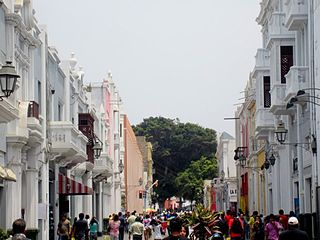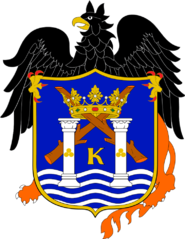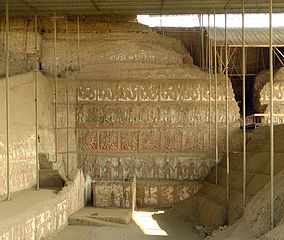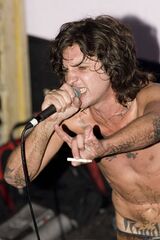Trujillo, Peru
Trujillo is a large city of Peru on the coast of the Pacific Ocean. It is a half day's drive north of the capital of Lima on the Panamerican Highway — even more, if the tourist either slows down to crawl through the roundabouts at the posted 10 kph, or does not but pulls over for the ritual traffic stop and check for paperwork. If hours of flat stretches of road with ocean views on the left and Andean foothills on the right induces sleep, the commute could take eternity.
Car tourists from Ecuador find ocean views on the right and Andean foothills on the left to be just as sleep-inducing.
The northern city is just south of one million residents. Reaching that landmark is a decades-old municipal goal and the subject of a current regional campaign. The key to increasing the birth rate is to seed nearby oceanfront beaches with comely white beachcombers.
Nicknames
As well as being the capital of the region of La Libertad, Trujillo has the distinction of having the most nicknames of any Peruvian metropolis. Its best-known nickname is Peru's Second City. The only reason for this nickname is to piss off Arequipa, whose residents think they are the best at everything and grudgingly accepted "Second City" only after finding out that Lima is the national capital although Arequipa should have been.
But enough about Arequipa. Trujillo is located on the banks of the Moche River — a pretty fine river, though lacking the soap suds that make the Rimac the nation's favorite water park. Trujillo is far away from any frontier, and was designated Meritorious City and Faithful to the Fatherland in 1822 by the Peruvian Congress, never once quitting Peru and joining Chile, to which it is nowhere near, or even Ecuador, which no one wants to be in anyway. Lima, by comparison, is much closer to Chile, and gets even closer whenever there is a war, often sneaking across the border until reinforcements arrive. For this reason, Trujillo has been the capital of Peru twice. Trujillo is often called Peru's Cradle of the Judiciary, as after these sojourns, Trujillo refused to release court documents to be returned to Lima for storage together with the proceedings from the times that Trujillo was not the capital.
Trujillo is also called the City of the Everlasting Spring, as neither winter nor summer want to have anything to do with it. Trujillo has only chilly coastal fog to refer to as "this miserable weather" and blame for bad health.
It is also called the Capital of Peruvian Culture, for people who still think that fish soup is especially palatable when served ice-cold and that pace-horse shows are worth a trip out of Lima. Trujillo's San Andres district is called the Miraflores of Trujillo, both for people who have not been to the real Miraflores and for people who are still there but think there might be a better one.
One thing that is clear is that Trujillo is the National Capital of Marketing Hype.
Symbols
The coat of arms has wavy lines that represent the many El Niño summers, in which blue water rises to the level of the front steps and floods out the Panamerican Highway in both directions. A griffin represents Trujillo's many fine Mobil gas stations. (A real griffin was unavailable and one of the area's vultures modeled for the seal, stood upon a golden retriever.) The baffling letter K is not part of the Spanish language but signifies the region's huge Kryptonite mines, which prevent the United States from sending Superman to conduct imperialism. The K also stands for another popular method of fighting imperialism: drinking Inka Kola (or, in a pinch, Konkordia) rather than Coke with its psychedelic effects.
Trujillo also has a flag with the coat of arms on it. This white flag is displayed whenever Trujillo wants to surrender to something (never to Arequipa), and also every December 29, to commemorate the date in 1820 when Trujillo was declared independent, and ceased to be known as a pueblo joven (squatters' city) of Lima.
History
In November 1534, conquistador Diego de Almagro founded the city, calling it Trvxillo of New Castilla, after the hometown of Bizarro. (Trvxillo is how you spell Trujillo at the end of a long game of Scrabble.) Only Chimu Indians were living there, but Almagro found it easy to promise them protection against the Incas, as they never asked who would protect them against the protectors. After three contentious years now known as The Almagro Beanfield War, the King of Spain declared Trujillo a "city" and granted it its coat-of-arms, and the Chimu chieftains still did not realize they were not going to be the Big Men on Campus. By 1544, there was a vibrant economy based on sugar cane, wheat, livestock, and enslaved Chimu. This began an era of frenzied building of churches and monasteries.
On February 14, 1619, an earthquake nearly wiped out the city and killed about 400 inhabitants. Trujillans celebrate Valentine's Day, which is the anniversary of this event. Local Valentine's Cards not only profess eternal love and friendship but express a hope that the recipient's roof does not collapse.
- Wall of Trujillo
Oceanside Trujillo was endangered by pirates and privateers, whereas inland Peruvian cities are beset by inland squatters, highwaymen, and rabid alpacas. Thus, the Wall of Trujillo was built to defend the city during the reign of Viceroy Melchor (before he moved to Middle Earth and started palling around with Sauron). It was 5.5 km in length and its construction employed 100,000 goldbrickers.
It was based on the wall that Leonardo da Vinci designed for Florence, Italy. Although baddies could scale the wall, enter through one of its ornate gates, or go behind it, the thinking was that they would never do either. They would think they had arrived in Florence instead, and would turn around and try to get back to Peru.
The historic district of modern Trujillo follows the line of the ancient Wall. Remnants are stenciled to tell the pedestrian what neighborhood he is in, whether POST NO BILLS or ORDERS TO SHOOT.
- Independence
“From this time forward, by the unanimous will of the people, Trujillo is free. I put our fate and that of our people under the protection of Heaven.”
Trujillo advanced from town to city to Diocese and then to Intendancy. In 1820, under intendant José Bernardo de Bungle in the Jungle, the Intendancy of Trujillo intended to be independent. Tragically, so many other cities and entire nations were doing the exact same thing at the same time throughout Latin America that no response from the King was forthcoming at all.
Trujillo had no way of knowing whether the declaration of the intendant's intentions was accepted or whether they would have to go to war. In the resulting uncertainty, the people of Trujillo bided their time and made a ton of money.
- Department of Trujillo
The ambiguity was settled in 1821, when General San Martín created the Department of Trujillo, a name dropped in the text of Peru's Constitution of 1823. Although Peruvians always insist that size does not matter, Trujillo in those days was enormous — accounting for half the entire nation — and San Martín placed the Department right between Housewares and Shoes, with three cash registers. Its jurisdiction extended to Cajamarca, Lambayeque, Chachapoyas, and Huamachuco, leading to yet another nickname for Trujillo: Peruvian Capital of Jawbreakers.
In 1824, they invited Simón Bolívar to "play" Trujillo. The Walls were full to the brim with roadies, sound equipment, pop music fans, and touts hawking unauthorized souvenirs. José Tomás Boves, the namesake of the Bovespa stock index, opened for Bolívar. Bolívar's "Admirable Campaign" played Trujillo to sold-out crowds from 9 June to 15 June, but during the final performance he issued his notorious "Decree" that anyone who wasn't a fan should be killed. Who knew he was a Muslim?
By the end of the 1800s, the Wall of Trujillo could no longer keep anyone out of Trujillo because most of Trujillo was outside of it. Mayor Víctor Larco Herrera tore down the Wall, beginning an era of greater-than-ever flow of traffic, with lesser-than-ever crashing into the Wall, an achievement for which he got a neighborhood (or "conurbation") named after him.
- Revolution of Trujillo
On July 7, 1932 — a leisurely six months after President Luis Sanchez Cerro had suspended civil liberties and allowed random arrests — angry insurgents attacked the O'Donovan Barracks at the edge of Trujillo. The insurgents captured and distributed machine guns, ammunition, and girlie magazines. They returned to the city, where Don Agustín Haya de la Torre was named Perfect (insurrection not spelling being their strong suit).
The suburbs joined in the insurrection. Tragically, that left the rest of Peru, which promptly arrived to get its city back. Cerro, famous for arresting without even a warrant, surprised no one by calling the firing squad before the trials were over. Fortunately, 60 of the 102 quickie death sentences were thwarted, not through skillful cross-examination but by virtue of the fact that the defendants were already dead. The President went from Cerro to hero.
The year 1932 came to be known as the year of barbarism, but it also gave Trujillo one more nickname, Peruvian Capital of Barbarism.
Trujillo today
As well as musty old history and sand-dune farming without the expedient of rain, Trujillo has many features that the tourist can assemble into a slide-show to impose on unwilling neighbors. The United Nations has formally designated Trujillo one of its Pretty Important Cities. The Inter-American Development Bank has named Trujillo an Emerging City, implying it will rise out of poverty; while the Pan-American Treaty Organization has given Trujillo awards for Sustainability, implying it will not.
The daily newspaper La Industria has gotten UNESCO awards for strident anti-U.S. editorializing. It takes a break from this only at midsummer, to warn residents that the sun is directly overhead and there is record risk of skin cancer, compared to the week before or after. Foreign newspapers such as the New York Times are also available, and it usually takes no more than two days to get them from seat-back pouches in jetliners being cleaned at the gate in Callao up to Trujillo for retail sale, which means the news is still fairly current.
Nearby Chan Chan has been added to the Registry of World Heritage sites as one of the hemisphere's largest piles of discarded cinder blocks. It is now impossible to rearrange any of the blocks without an appointment with either a diplomat or a tax-exempt international bureaucrat, and most of these are down in Lima.
The city center has inspiring wrought-iron architecture. The wooden balconies typical in Lima were phased out in Trujillo, as they appealed more to the termites indigenous to this sand dune than the view of the neighborhood appealed to Trujillo residents.
The San Andres district offers fine hotels and restaurants, many operated by Europeans to please tourists desirous of nuanced toppings and small portions, while local Bed 'n' Breakfasts offer heartier alternatives for tourists who do not have money to burn. An even flintier alternative in the City of the Griffin is to go down to the grifo (the Mobil station) and see if the slush machine is working today.
See also
| Featured version: 28 May 2016 | |
| This article has been featured on the main page. — You can vote for or nominate your favourite articles at Uncyclopedia:VFH. | |





